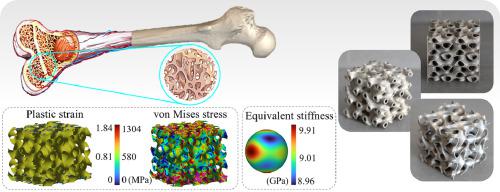International Journal of Mechanical Sciences ( IF 7.1 ) Pub Date : 2023-03-24 , DOI: 10.1016/j.ijmecsci.2023.108353 Mansoureh Rezapourian , Iwona Jasiuk , Mart Saarna , Irina Hussainova

|
This study investigates Ti6Al4V Split-P triply periodic minimal surface (TPMS) structures produced by selective laser melting for the first time. The designs include two different cell morphologies (CM) with five different relative densities (RD). Scanning electron microscopy is utilized to assess the manufacturability and accuracy of the 3D printed Split-P lattice structures. The quasi-static mechanical responses are then studied to identify the failure mechanisms of each lattice type. Afterward, the stress-strain behavior and plateau stress responses are explored to evaluate the load-bearing capacity and energy absorption of five Split-P lattices. Furthermore, finite element analysis is performed to gain insight into the elasto-plastic behavior of the Split-P structures, and unit cell homogenization is employed to determine the equivalent stiffness tensor. The results demonstrate that the elastic modulus, yield strength, and ultimate strength of the 3D printed Split-P lattices range from 1.50 to 3.50 GPa, 57.95 to 152.74 MPa, and 93 to 170 MPa, respectively. Depending on RD and CM, load-bearing capacity range from 0.04 to 0.17. The energy absorption capacity and plateau stress of lattices vary from 22 to 61 MJ/m3 and 30 to 63 MPa, respectively. Gibson-Ashby power law represents the elastic modulus and yield stress of the Split-P lattices as a function of RD and reveals a stretch-dominated deformation behavior. Unit cell homogenization on Split-P structures with zero isovalue shows isotropy in mechanical properties and anisotropy for lattices with non-zero isovalue. Ti6Al4V Split-P lattices with the highest surface area and surface area-to-volume ratio, among other TPMS, can achieve mechanical properties close to those of trabecular and cortical bones, making them suitable for bone implants in load-bearing applications.
中文翻译:

用于骨组织工程的选择性激光熔化 Ti6Al4V split-P TPMS 晶格
本研究首次研究了通过选择性激光熔化产生的 Ti6Al4V Split-P 三重周期最小表面 (TPMS) 结构。这些设计包括两种不同的细胞形态 (CM) 和五种不同的相对密度 (RD)。扫描电子显微镜用于评估 3D 打印的 Split-P 晶格结构的可制造性和准确性。然后研究准静态机械响应以确定每种晶格类型的失效机制。之后,研究了应力-应变行为和平台应力响应,以评估五个 Split-P 晶格的承载能力和能量吸收。此外,还进行了有限元分析以深入了解 Split-P 结构的弹塑性行为,并采用晶胞均质化来确定等效刚度张量。结果表明,3D 打印的 Split-P 晶格的弹性模量、屈服强度和极限强度范围为 1.50 至 3.50GPa、57.95 至 152.74 MPa和 93 至 170 MPa,分别。根据 RD 和 CM,承重范围从 0.04 到 0.17。晶格的能量吸收能力和平台应力从22到61 MJ / m 3和30到63 MPa不等, 分别。Gibson-Ashby 幂律表示作为 RD 函数的 Split-P 晶格的弹性模量和屈服应力,并揭示拉伸主导的变形行为。具有零等值的 Split-P 结构的晶胞均匀化显示机械性能的各向同性和具有非零等值的晶格的各向异性。具有最高表面积和表面积体积比的 Ti6Al4V Split-P 晶格与其他 TPMS 相比,可以实现接近小梁骨和皮质骨的机械性能,使其适用于承重应用中的骨植入物。











































 京公网安备 11010802027423号
京公网安备 11010802027423号